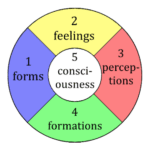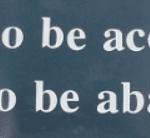Definition of Karma

Karma means action, the set of habitual responses and modes of perception constraining the being into programmatic responses, embodied in the 12 Nidanas or links. It is the response to phenomena, creating seeds for later effects.
Karma is NOT a system of punishment and reward, but a psychological cause-and-effect explanation. Karmic outcomes are not proportional.
I find that meditation and contemplation on karma has a curious effect. It can make us paranoid, because karma is inevitable. However, it can also generate a determined attitude. We all have difficult to work with karma, but many people have overcome significantly negative experiences. That inspires me, for sure. Using our karma to become better human beings is essential to Buddhism. But we can’t do that if we don’t really get it deeply and accurately.
I must understand karma in general to overcome my specific karma. It’s a difficult field of study. I’ll be at it for the rest of my life.
Karma Summary Table
Karma Summary Table
| Aspect | Description |
|---|---|
| Definition | Karma, originating from Sanskrit, translates to “action” or “deed.” It encapsulates the idea that every action, whether physical, verbal, or mental, has consequences. |
| Cycle of Samsara | Karma operates within the framework of samsara, the cycle of birth, death, and rebirth in which beings are trapped due to ignorance, desire, and attachment. |
| Types | Karma encompasses positive actions (good karma), motivated by compassion, generosity, and wisdom, as well as negative actions (bad karma) driven by greed, hatred, and ignorance. |
| Determinism | Karma is not deterministic but rather emphasizes the potential for change and growth. Individuals have the capacity to cultivate positive karma through mindful actions and ethical living. |
| Interconnectedness | Karma highlights the interconnectedness of all beings, emphasizing how individual actions impact not only oneself but also others and the environment. |
| Spiritual Path | Reflection on karma is central to meditation and contemplation, helping practitioners deepen their understanding of the causes shaping their lives and guiding ethical conduct. |
Table of Contents
Secrets of Meditation for Anxiety
Like millions of people, you may have suffered from anxiety for years. Meditation, yoga, peaceful music – it never works. It takes too long, and it’s not stable. Why? Because peace is treated as a cause for freedom, but it’s not – it’s the result. The cause to free yourself from anxiety is completely different.
Click now to Overcome Anxiety for good.
Related Terms for Karma
Karma Related Terms
Certainly! Here’s an LSI (Latent Semantic Indexing) list for the concept of Karma, sectioned for clarity:
Definition:
- Karma, derived from Sanskrit, signifies “action” or “deed”.
- It encapsulates the principle that every action, whether physical, verbal, or mental, carries consequences.
- Karma is the cornerstone of understanding cause and effect in Tibetan Buddhism.
Cycle of Samsara:
- Within the cycle of samsara, Karma dictates the trajectory of birth, death, and rebirth.
- Beings are ensnared in samsara due to ignorance, desire, and attachment.
- Understanding Karma is essential for navigating the cycle of existence.
Types of Karma:
- Karma encompasses both positive (good) and negative (bad) actions.
- Good Karma arises from virtuous intentions such as compassion, generosity, and wisdom.
- Bad Karma stems from destructive motives like greed, hatred, and ignorance.
Determinism and Change:
- Karma is not deterministic; it allows for the potential for transformation and evolution.
- Individuals possess the agency to cultivate positive Karma through mindful conduct and ethical living.
- The understanding of Karma empowers individuals to shape their destiny.
Interconnectedness:
- Karma underscores the interconnected nature of all beings and phenomena.
- Actions not only affect oneself but also ripple outward to impact others and the environment.
- Recognizing interconnectedness fosters a sense of responsibility and compassion.
Spiritual Path and Practice:
- Contemplation of Karma is integral to meditation and spiritual practice.
- Reflecting on Karma deepens insight into the causes shaping one’s life and guides ethical behavior.
- Karma serves as a guiding principle on the path to enlightenment and liberation.
This sectioned LSI list offers a comprehensive breakdown of Karma, covering its definition, role in samsara, types, implications for determinism and change, interconnectedness, and significance in spiritual practice.
Difference between Buddhist and Hindu conceptions of Karma
In Hinduism, karma is largely regarded as fixed and immutable – destiny. Karma is an inherited aspect of birth and you can only experience its outcome as unchangeable. Buddhism regards karma as the net of suffering – samsara – and regards it as ultimately exhaustible and escapeable through proper view and meditation. It is NOT destiny.
Good, Bad, Neutral, and Non-Karma or Transcendence
Good Karma is the engagement in virtuous acts (love, compassion, generosity, etc.). Bad karma is engagement in negative acts (killing, lying, stealing, sexual misconduct, drunkenness, etc.). Neutral karma does not create either positive or negative effects for the being but may generate habitual responses – scratching your beard, for example. Transcendence of karma is understanding and meditating on it to arrest the flow (Hinayana) or purify it altogether.
Karma is primarily the engagement with habits of mind, not a system of punishment from a god. Morality has nothing to do with it. This is a highly misunderstood point. If you engage in virtuous acts, you will see virtue inherent in the world. If you engage in peace, your mindstream will seek out peaceful situations. If you engage in hate, the mind will find it. This is a multi-lifetime process, so past karma can impel the mind in unknown ways.
Transcendent karma is merit, the engagement in the truth of leaving samsara by seeing the non-existence of the self. Repeatedly engaging in this approach with courage and faith generates a type of karma that helps you to escape from the chain altogether, either stopping or totally dissolving it. This point is unknown to most people when they discuss it. They only see Good or Bad karma, and remain unaware of transcendent merit.
How to meditate like a yogi
and enter profound samadhi
The Rule or Law of Karma
You cannot escape your karma – it is cause and effect. While arhats can stop the flow and attain Nirvana, they still have latent karmic seeds. These must be experienced if they take rebirth. However, the effects are not proportional, so a skilled meditator can ripen and purify vast amounts of karma in a very muted manner.
Explanation of Karma in Buddhism: the 12 Nidanas
Karma (etymologically Sanskrit for Activity) is probably the most difficult, complex, and misinterpreted aspect of Buddha’s teachings. It is systematized in the 12 nidanas or links of dependent origination. The Nidanas represent a multi-lifetime journey, with the first 3 being past lifetimes, especially the previous one, nidanas 3-10 are the present lifetime (3 overlaps from past to present and are thus in both lifetimes), and 11-12 are the future lifetime – the next rebirth. Obviously, all the nidanas occur in every lifetime, but they are highlighted in the presentation as to which is most important for the explanation.
The 12 Nidanas in Buddhism – Dependent Origination
Nidana means Cause or motivation. The 12 Nidanas simply roll from lifetime to lifetime to lifetime. Karma is truly about a multiple lifetimes recurrence. The main lessons of karma are
- Karmic rebirth is endless by itself.
- Karma can be ended by application of the dharma (Buddha’s teachings).
The endlessness is endless only if the being never acts to end it. This graphic illustrates the 12 Nidanas as the Wheel of Life.
The Nidanas have 2 main stopping points. The first is between Vedana (feeling) and Trishna (thirst or craving). The second is Avidya (Skt) or Marigpa (Tib.) The figure demonstrates the first. It is first on the path, though it is later in the Nidanas. This is because it is far easier to accomplish. Meditative skill can be lower and mastery of view can be far more basic in order to accomplish this. Soso Tharpa, or individual liberation is the name.
Before detailing the methods of exit, it is essential to understand the terrain. Going through the Nidanas, we have
| 1 | Avidya / Marigpa – Ignorance | The fundamental ignorance of reality from which existence as a conditioned being begins. Not understanding the path and truth of cessation. |
| 2 | Samskaras – Formations | Consciousness really begins in the past lifetime and continues into the present. It extends as continuous experience and is probably the most stable trait continuing from life to life. Vijnana means Divided Knowing or Mind. Divided means that Consciousness has both Subject and Object. It is divided into those two aspects. Hinayana posits that Consciousness is an illusion of continuous experience and is actually a series of very brief instants (360/second – like a movie) that occur so rapidly we falsely perceive it as continuous.It breaks down into the 6 sense consciousnesses plus the defiled and alaya-vijnana. |
| 3 | Vijnana / Consciousness / Mind | The mind senses whether it likes, dislikes, or is neutral to the Object. |
| 4 | Namarupa – Name and Form | This is somewhat Identity. Name is the combination of mental factors. Form is the coalescence of the elements – earth, water, fire, air, and space. |
| 5 | Shadayatana – six senses | Built on top of the form, the six senses are seeing, hearing, touching, smelling, tasting, and mental consciousnesses. The last pertains to the awareness of mental events. |
| 6 | Sparsa – Contact | The six senses touch external objects. |
| 7 | Vedana – Feeling | At this point, the mind internalizes the Craving, identifying with it as a strong habituation. 4 types occur – Grasping at sense pleasures, ideas, to morals / vows, to self. |
| 8 | Trishna – Thirst / Craving | The mind develops wantingness or aversion (negative desire). Craving is the key point of abandonment for liberation. (See the following). |
| 9 | Upadana – Grasping / Clinging | The Grasping turns into Identity. This will occur with the strongest trait or combination of traits. If the being grasps at anger, the karmic cause will push them towards aggressive and even hellish states. If it is gluttony, they will go towards desperate states with tremendous want. Ignorance tends toward animal states, sexual desire to human states, jealousy to demi-gods, and pride to god states. Stable meditation leads to higher gods of light and formlessness (pure consciousness and so forth). Existence has the character of being the next rebirth in potentia. In other words, if the being died at any moment, an existence within their karma would manifest, driving them to the next rebirth. Notably, that existence is constantly in flux, such that the Existence on one day would be slightly different on the next. Years later, it may be vastly altered by the karmic accumulations and ripening the being has undergone. When this state ceases, it leads to… |
| 10 | Bhava – Becoming / Existence | The future life will end, leading to another rebirth in an endless cycle. This cycle is characterized by Dukkha / Suffering. Dukkha is an inescapable fact of existence but is not the entirety of existence. All that lives will experience suffering in multiple ways. Thus the Buddha taught how to escape the cycle of conditioned existence or Karma. |
| 11 | Jati – Birth | Rebirth in the next life. The present life extends at the time of death, through the Bardo or in-between state to seek out the next birth based on the most pressing habits of karma. |
| 12 | Jara-Marana – Death | The future life will end, leading to another rebirth in an endless cycle. This cycle is characterized by Dukkha / Suffering. Dukkha is an inescapable fact of existence, but is not the entirety of existence. All that lives will experience suffering in multiple ways. Thus the Buddha taught how to escape the cycle of conditioned existence or Karma. |
The precise and detailed methods of the Hinayana allow the meditator to halt the flow of karma indefinitely. This would occur in the middle 8 Nidanas in what we’re calling the present lifetime. Hinayana methods focus on the link between Feeling and Grasping. It is possible to sever this link in meditation thus severing the relentless flow of karma.
The Vedana / Feeling of something arises as the mind conceives of the object (Sparsa / Contact). This leads to some sense of liking/disliking/neutrality, which creates Desire / Aversion / Ignorance as strategies to relate to the perception. This point allows the meditator to cut the chain of interdependence by allowing Vedana to dissolve in meditation without strengthening to Grasping. Here is the method:
- The skillful Hinayana meditator develops a stable Samadhi/meditation first.
- The concentration (mental focus) turns to the arising of sense perceptions.
- The focus sees how the Effect of Feeling transforms into the cause – Grasping. Feeling is not karma, it is the result of previous karma. Feelings arise inescapably until karma is exhausted. The point here is to see the Feeling arising in a very subtle, first-thought manner.
- Watch the Feeling intensify into Craving. Closely and objectively experiencing this process allows the mind to release Feeling before it turns into Craving. The skilled meditator creates the habit of releasing Feeling, of simply not going along with the Nidana chains from this point.
- Hinayana practitioners abjure the world of pleasures, living in isolation and meditating many hours per day on this and other approaches, such as the selflessness of the person. Thus their Existence becomes one of not Craving, hence not Grasping, hence not Existing. They thus overcome the impulsion to take rebirth and can abide in Nirvana or Peace. It means the mind consciousness is simply without Klesha or negative emotions. However, the seeds still exist, so it is not full enlightenment.

Flow, the profound mental state, also called Peak Performance, can be attained with meditation and can be ‘triggered’ at will, with enough discipline. Guide to Flow Mastery will teach you how.
At this point, the meditator is called a non-returner as in not returning to Samsara. They are also called Arhats or Foe-Destroyers, meaning they have destroyed the enemy of Klesha and the four Maras.
The second exit pertains to full enlightenment. Marigpa means Not Knowing or Not Aware – not (Ma) realizing the Nature of Reality (Rigpa). This nature is expressed in many different ways according to the different schools of Buddhist philosophy. Unwinding the Nidanas at this point, at the fundamental ignorance, leads to full enlightenment. It’s critical to realize that all the Nidanas are occurring constantly, but each links to the next in a causal manner. Then the cycle repeats in a different way. With a different focus, one runs through the cycles of the Nidanas repeatedly. It’s essentially a process of creating seeds or laying in habitual tendencies in the alaya, the ground nature, the storehouse consciousness of the mind.
Because we have been cycling in Samsara, the circular nature of existence, for beginningless lifetimes, the habitual karmic traces in the alaya are inexhaustible. Karma can be ripened and exhausted more or less rapidly through the sophisticated methods of Tantra.
4 Requirements of a Complete Karmic Act
The 4 necessary components to make an act a complete karmic act are
- Intent – Volition is king in karma. In order to accumulate karma the action must be intentional, not incidental.
- Plan – the mind must make a process, however simple, for the act.
- Execution – the being must perform the act in question. Karma still accumulates by intent and planning, but far less.
- Satisfaction – Non-regret, the feeling that the act was appropriate. Immediate regret, genuine, diminishes karma greatly.
4 Reversals of Karma
The 4 pieces to purifying karma.
- Bringing specific actions or kleshas (negative emotions) to mind, especially in meditation.
- Contemplating the negative outcomes of the action.
- Experiencing and increasing regret and shame.
- Vowing never to do it again and instead to perform the reverse virtue.
Repeating these steps again and again will, depending on the depth of the karma, slowly reverse it, bringing purification.
Why the Buddha taught Karma
Many Western Buddhists do not believe in karma in that way. (Eastern lay practitioners have their own misunderstandings of karma, but that is another issue.) There is a tendency to believe in a tit-for-tat version of karma, kindergarten karma. If you punch somebody, then in the next life they will punch you back. It’s hardly so coarse. It may create a karmic connection – a feeling that you intensely like or dislike someone, for example.
The Western understanding that karma is an instantaneous response is incorrect. There is no instant karma. The universe is not recording your acts. Karma is not a punishment and reward system. In fact, it is not a moral system at all. It is a system of cause and effect. If you habituate yourself to certain activities, those situations will tend to draw you toward them because your mind is attracted to them. You will strengthen that, with some overriding trait, to becoming that person who likes or hates such and such a thing, be it sex, food, money, safety, an ethnic group, fame, thrills, or whatever.
The constant seeking of something, wanting it or the constant pushing away of something else becomes the karma. It is who you are, at least in part. When you sum those strongest forces in your being, they create your character and personality, what you think of as yourself, and what appears to you as other.
Society has karma, too.
Karma is also intermingled between people, so you will naturally project your own karmic perceptions onto other people. This is why some people can really appreciate someone who seems very rude or dislike someone they think is awesome. The person is neither of those things in and of themselves. But the person perceiving them applies their own karmic ideas. Karma is a matter of how a person sees the world and acts based on their perceptions.
Many Western Buddhists make this mistake. Karma is not a moral system. This is a misguided perception that will cause your path to diverge and distort from the actual path. We avoid negative karma because it makes us suffer, not because it is morally wrong. It may be morally wrong, but that is not the point. The point is it makes us suffer in the future. Violent karma creates a violent made which draws the person towards violence which will eventually be turned against the person. There are many more subtleties to it, but this is an essential point.

If a person is attached to their body (and aren’t we all) they will suffer when it is harmed. However, if you have no attachment to the body, you will not suffer when it is harmed. You may feel pain, but you can transcend the suffering. If you have ever seen the picture of the monk who sits in samadhi as he burns himself to death, this will make sense.
The point is that all these kleshas, negative emotions, drive us away from peace. If you take one point away about karma, this is it. If something bad happens because of karma, it is not a punishment. There is no one to punish you. There is no creator of punishment.
Karma is a natural flow of cause and effect. If you step in front of a moving car, you will be killed. The moving car is the cause, death is the effect. This is, in fact, an excellent metaphor for karma. If you step in front of karma, it will cause you to suffer. It will push you into states of suffering. That is the main point of the teaching.
FAQ
What is the true meaning of karma?
The true meaning of karma is action, meaning the constant impelled movement, the wandering, of sentient beings.
What is the basic belief of karma?
The basic belief of karma is that our actions are based on desire and lead to further entrenchment in the cyclical nature of existence through endless rebirth.
What is an example of karma in real life?
Here is an example of karma in real life: screaming at a friend and they no longer talk to you. Eating too much and getting fat.
Does karma always come back?
Karma does not always ‘come back,’ per se. Karma is inevitable, but that means it must ripen in some way. Yogis intentionally ripen their karma in a meditative manner, purifying vast amounts in a muted and controllable fashion.
Is karma a real thing or not?
Relatively, karma is a real thing in that what you put into the world without regret shapes your mind and your being. Ultimately, karma is not a real thing, it is an empty collection of impulses and causal relations without inherent thingness.
Can karma be good and bad?
Karma can be good and bad, or neutral. It can also manifest as merit, a special type that propels the person out of the karmic stream using the force of karma itself.
Who controls karma?
No one controls karma. It is innately woven into the fabric of beings’ minds and arises when the conditions appear.
How do you get rid of bad karma?
To get rid of bad karma, it is necessary to acknowledge it, regret it, perform purification practices, and vow to never repeat the actions.
Summary
Karma is the Buddha’s science of interconnectedness. It is detailed as the nidanas or the links of interdependent existence. These 12 links connect one the next and travel inexorably over lifetimes as building causality, leading to effect, which generates more causal factors culminating in the effect of endless lifetimes.
Mantra of Interdependence
The twelve Nidanas and the 5 Skandhas are summarized in the Pratītyasamutpāda mantra or the mantra of dependent origination:
OM YE DHARMA HETU-PRABHAVA HETUM TESHAM TATHAGATO HYAVADAT TESHAM CHA YO NIRODHA EVAM VADI MAHASHRAMANAH SVAHA
Shariputra, a student of the Buddha, was asked to summarize the Buddha’s teaching, and he said this. It means, according to Nalanda Translation:
Regarding dharmas that arise from a cause, the Tathagata taught their cause and also their cessation. Those were the words of the Great Mendicant.

May all beings be happy
May all beings be peaceful
May all beings be safe
May all beings awaken to the light of their true nature
May all beings be free







